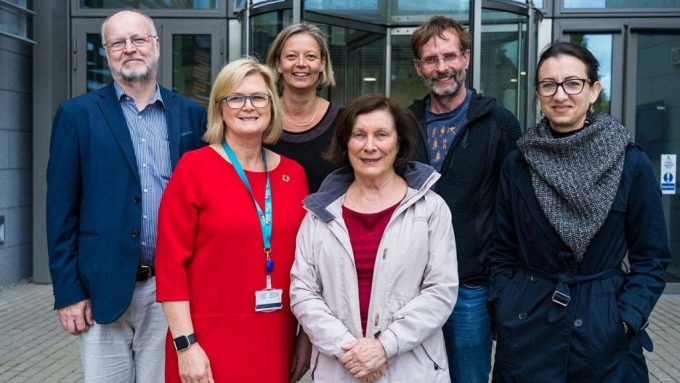
Professor Elizabeth Rata (front middle) with other conference attendees. Photo: Daniel Prazak, courtesy of University of Auckland
The Faculty of Education and Social Work’s Professor Elizabeth Rata, who leads the Knowledge-Rich School Project, gave a keynote address about the project’s Curriculum Design Coherence (CDC) Model at the European Association for Curriculum Studies conference in Ireland last month.
The CDC Model helps teachers design effective courses that accommodate the relationships between subject concepts and content, and between that subject knowledge and subject competencies.
As well as its usefulness for teachers in designing courses, the CDC Model has significant potential for initial teacher education and teacher professional development globally. The model has already received interest from two large teacher education programmes based in the UK involving over 120 primary and secondary schools. Two members of the project team are returning to the UK in September to work with the programme leadership.
“These programmes in the UK think the CDC Model could be very valuable for their teachers,” says Professor Rata. “It was really encouraging to hear that so many people saw our model as a very useful design tool – from initial teacher education students to highly experienced teachers.”
She says the model addresses the curriculum versus pedagogy issue educators face – the difficulty of finding the right balance between curriculum design and delivery.
“A lot of emphasis is put on delivery or pedagogy, and rightly so – it’s important that teachers’ delivery is engaging and creative,” says Professor Rata.
“However, sometimes that comes at the expense of curriculum design, which is equally important. The CDC Model addresses this issue by looking at design and delivery separately first, and then putting them together.”
She says the CDC Model is particularly important for New Zealand because this country has a localised curriculum with individual teachers and schools required to build their own curriculum across the school, as well as deciding what to teach in each course. This leads to a wide variation in the selection of knowledge that students receive, varying in different parts of the country and even in different schools within a city.
“It was really encouraging to hear that so many people saw our model as a very useful design tool – from initial teacher education students to highly experienced teachers,”
Once those difficult decisions are made about what to teach, teachers still need to design the lessons coherently within a course, across a year’s programme, as well as throughout the years, from Year 1 to Year 13. This is a huge task, especially when done on a school-by-school basis.
“The CDC Model could help standardise the curriculum, which would ensure that all children get the same knowledge, no matter where they live,” says Professor Rata. “Teachers would still design and deliver their programmes, but the model enhances their professional expertise by helping them to design the components of knowledge in a coherent way.”
The project team will present at several more educational conferences this year, including the New Zealand Association for Research in Education Conference in November and the British Educational Research Conference being held in Manchester in September.
Project member and model co-designer Dr McPhail will also talk about the model in Atlanta later this year. Closer to home, the project team will hold a Symposium in the Faculty of Education and Social Work on Tuesday 19 November.
The much-delayed English draft curriculum is now out for consultation, generating discussion from teachers.
Research from AUT demonstrates arts, culture and recreation have positive impacts on all aspects of…
How effective has the school phone ban been in achieving its aims? Researchers from the…
School camps and excursions deliver hands on learning experiences, helping to consolidate classroom learning.
Innovations in AV technologies present new opportunities to engage with students. We look at how…
A new report from the University of Auckland’s Our Voices Project asks young people what…
This website uses cookies.